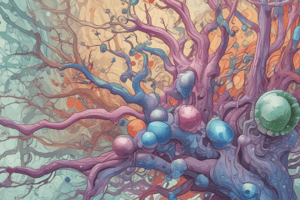Podcast
Questions and Answers
What is the mechanism of action of anticholinesterases?
What is the mechanism of action of anticholinesterases?
- Inhibit the release of acetylcholine
- Stimulate the synthesis of acetylcholine
- Inhibit the metabolism of acetylcholine (correct)
- Activate the breakdown of acetylcholine
What is the result of anticholinesterases inhibiting acetylcholinesterase?
What is the result of anticholinesterases inhibiting acetylcholinesterase?
- Reduced duration of action of acetylcholine
- Prolonged duration of action of acetylcholine (correct)
- Increased synthesis of acetylcholine
- Decreased release of acetylcholine
What is a characteristic of reversible anticholinesterases?
What is a characteristic of reversible anticholinesterases?
- Structurally similar to acetylcholine (correct)
- Permanently inhibit acetylcholinesterase
- Directly stimulate cholinergic receptors
- Structurally similar to atropine
Which of the following is a use of reversible anticholinesterases?
Which of the following is a use of reversible anticholinesterases?
What is the rationale for using atropine in the management of organophosphorus poisoning?
What is the rationale for using atropine in the management of organophosphorus poisoning?
What is a group of drugs used to treat glaucoma?
What is a group of drugs used to treat glaucoma?
What is the primary objective of rapid decontamination in initial OP poisoning treatment?
What is the primary objective of rapid decontamination in initial OP poisoning treatment?
Which of the following is a characteristic of muscarinic symptoms in OP poisoning?
Which of the following is a characteristic of muscarinic symptoms in OP poisoning?
What is the primary mechanism of action of oximes in OP poisoning treatment?
What is the primary mechanism of action of oximes in OP poisoning treatment?
Which of the following drugs is used to control convulsions in OP poisoning?
Which of the following drugs is used to control convulsions in OP poisoning?
What is the primary goal of maintaining an intravenous line in OP poisoning treatment?
What is the primary goal of maintaining an intravenous line in OP poisoning treatment?
What is the golden period for reactivation of acetylcholinesterase in OP poisoning?
What is the golden period for reactivation of acetylcholinesterase in OP poisoning?
Which of the following drugs is used to treat glaucoma?
Which of the following drugs is used to treat glaucoma?
What is the primary effect of nicotinic symptoms in OP poisoning?
What is the primary effect of nicotinic symptoms in OP poisoning?
What is the origin of physostigmine?
What is the origin of physostigmine?
What is the solubility characteristic of physostigmine?
What is the solubility characteristic of physostigmine?
What is a common use of physostigmine?
What is a common use of physostigmine?
Which of the following drugs is used to treat Alzheimer's disease?
Which of the following drugs is used to treat Alzheimer's disease?
What is the characteristic of edrophonium?
What is the characteristic of edrophonium?
What is a common adverse effect of cholinomimetics?
What is a common adverse effect of cholinomimetics?
What is the effect of aging on organophosphate poisoning?
What is the effect of aging on organophosphate poisoning?
What is the structure of neostigmine?
What is the structure of neostigmine?
What is the use of neostigmine in anesthesia?
What is the use of neostigmine in anesthesia?
What is the effect of cholinomimetics on the eye?
What is the effect of cholinomimetics on the eye?
Study Notes
Mechanism of Action of Anticholinesterases
- Anticholinesterases (AchE) inhibit the breakdown of acetylcholine (ACh) in the synaptic space, leading to an increase in ACh levels.
- Reversible AchE inhibitors, such as physostigmine and neostigmine, have a similar structure to ACh and bind to the enzyme, temporarily inhibiting it.
- This indirect mechanism allows ACh to accumulate in the synaptic space, leading to a cholinergic effect.
Physostigmine vs Neostigmine
- Physostigmine:
- Natural alkaloid
- Tertiary amine structure
- Highly lipid soluble, allowing it to cross the blood-brain barrier
- Can cause convulsions at high doses
- Neostigmine:
- Synthetic derivative
- Quaternary amine structure
- Not lipid soluble, unable to cross the blood-brain barrier
- Less likely to cause convulsions even at high doses
Therapeutic Uses of Reversible Anticholinesterases
- Alzheimer's disease: Galantamine, Tacrine, Donepezil, Rivastigmine
- Myasthenia gravis: Neostigmine, Pyridostigmine
- Post-operative reversal of muscle relaxation: Neostigmine
- Atropine poisoning: Physostigmine
Uses of Cholinomimetics
- Edrophonium: Short-acting, diagnosis of myasthenia gravis
- Physostigmine: Intermediate-acting, treatment of glaucoma and atropine poisoning
- Neostigmine: Intermediate-acting, treatment of paralytic ileus, urinary retention, myasthenia gravis, and reversal of non-depolarizing neuromuscular blockers
- Donepezil: Lipid soluble, treatment of Alzheimer's disease
- Organophosphates: Irreversible inhibitors, used as insecticides and nerve gas
Adverse Effects of Cholinomimetics
- SLUDGE syndrome: Salivation, lacrimation, urination, defecation, gastrointestinal upset, and emesis
- CNS stimulation
- Miosis and spasm of accommodation
- Bronchoconstriction and tracheobronchial secretions
- AV block
Organophosphate Poisoning and Management
- Muscarinic symptoms: Diarrhea, urination, miosis, bronchospasm, bradycardia, lacrimation, emesis, and sweating
- Nicotinic symptoms: Muscle fatigue and weakness, twitching, fasciculation, tremors, muscle paralysis
- CNS symptoms: Ataxia, confusion, convulsions, depressed respiration, and cardiovascular function
- Initial treatment: Rapid decontamination, maintaining respiration, suction of bronchial secretions, catheterization of the urinary bladder, and control of convulsions
- Atropine: Antimuscarinic agent, blocks all actions of ACh on muscarinic receptors
- Oximes: Cholinesterase reactivators, reactivate AchE inhibited by organophosphates
Reactivation of AchE by Oximes
- Golden period: Within 2 hours of exposure, oximes can prevent aging and reactivate AchE
Drugs Used in Glaucoma
- Parasympathetic agents: Pilocarpine, physostigmine, dipivefrin, apraclonidine, and brimonidine
- Adrenergic agonists: Timolol, levobunolol, carteolol
- Beta blockers: Timolol, levobunolol, carteolol
- Carbonic anhydrase inhibitors: Acetazolamide, dorzolamide
- Prostaglandin analogs: Latanoprost, travoprost
- Osmotic agents: Mannitol, glycerin
Studying That Suits You
Use AI to generate personalized quizzes and flashcards to suit your learning preferences.
Related Documents
Description
This quiz covers the mechanism of action, pharmacological actions, and uses of anticholinesterases, as well as the adverse effects of cholinomimetic drugs. Apply your knowledge to real-world scenarios, such as Alzheimer's and myasthenia gravis.




